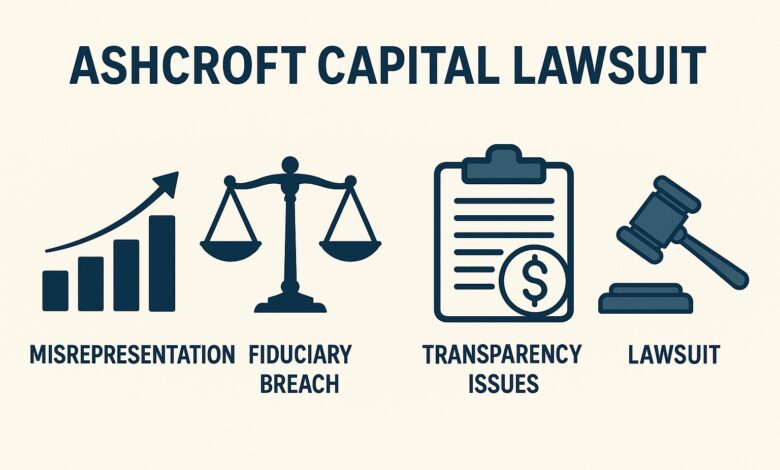Ashcroft Capital Lawsuit: Unveiling Allegations, Investor Concerns, and Industry Impact
A Deep Dive into Investor Allegations, Financial Transparency Issues, and the Growing Regulatory Scrutiny Surrounding Ashcroft Capital

Introduction
The Ashcroft Capital lawsuit has become a critical case in the real estate syndication industry, raising serious questions about investor protection, financial transparency, and fiduciary responsibility. Allegations surrounding Ashcroft Capital misrepresentation, fund misuse, and fiduciary breaches have prompted investors and regulatory bodies to take a closer look at the firm’s practices. This article explores the Ashcroft Capital lawsuit in detail, highlighting its causes, key allegations, and potential outcomes.
What is the Ashcroft Capital Lawsuit?
The Core of the Legal Dispute
The Ashcroft Capital lawsuit revolves around accusations of misleading financial projections, unauthorized use of funds, and inadequate investor reporting. Investors claim that Ashcroft Capital failed to disclose material risks and breached fiduciary duties. These concerns have led to legal action, with the case gaining national attention.
Investor Complaints
Key complaints in the Ashcroft Capital lawsuit include:
-
Ashcroft Capital misrepresentation of investment returns.
-
Failure to disclose material risks in real estate syndications.
-
Unauthorized use of investor funds without prior consent.
-
Ashcroft Capital financial reporting issues, including incomplete investor updates.
Key Allegations Against Ashcroft Capital
Ashcroft Capital Misrepresentation of Returns
Misleading Financial Projections (H4)
Investors allege that Ashcroft Capital misrepresented projected returns, offering overly optimistic forecasts that were not supported by market data. These misleading financial projections contributed to inflated investor expectations.
Breach of Fiduciary Duty
Ashcroft Capital Fiduciary Breach (H4)
The lawsuit accuses Ashcroft Capital of fiduciary breaches, claiming the firm prioritized its own profits over the best interests of investors. This breach of fiduciary duty is central to the ongoing legal battle.
Lack of Transparency in Operations
Ashcroft Capital Transparency Issues (H4)
One of the most significant issues is lack of transparency. Investors argue that Ashcroft Capital failed to provide timely, detailed financial reports, creating concerns about real estate syndication transparency and accountability.
Regulatory Scrutiny and SEC Investigation
Ashcroft Capital SEC Investigation
The Ashcroft Capital lawsuit has reportedly attracted the attention of the Securities and Exchange Commission (SEC). The SEC is said to be reviewing whether Ashcroft Capital’s actions violated securities laws.
Potential Securities Violations
The allegations suggest potential Ashcroft Capital securities violations, which, if proven, could result in regulatory penalties and industry-wide reforms to improve syndication transparency.
Real Estate Syndication Practices Under Review
Fund Misuse and Syndication Mismanagement
Ashcroft Capital Fund Misuse (H4)
The lawsuit claims unauthorized use of funds and mismanagement of real estate syndications, with investors alleging that capital was diverted without proper disclosure or approval.
Property Valuation Disputes
Discrepancies in Ashcroft Capital property valuations are also highlighted. Inflated valuations may have misled investors about asset performance and overall portfolio health.
Investor Due Diligence and Industry Implications
Importance of Investor Due Diligence
The Ashcroft Capital investor due diligence failure is a key learning point. Investors are now urged to conduct thorough reviews before participating in real estate syndications to avoid similar pitfalls.
Broader Industry Impact
The Ashcroft Capital lawsuit may lead to industry-wide changes, emphasizing passive real estate investing issues, increased transparency, and stricter regulatory oversight to safeguard investor protection in syndications.
Potential Outcomes of the Ashcroft Capital Lawsuit
Settlement Possibilities
Legal experts believe the case could conclude with a settlement, allowing Ashcroft Capital to avoid a prolonged trial without admitting guilt.
Court Ruling and Future Precedent
If the case proceeds to a verdict, it may set a powerful precedent regarding multifamily investment risks, fiduciary standards, and real estate syndication practices across the industry.
FAQs About the Ashcroft Capital Lawsuit
What is the Ashcroft Capital lawsuit about?
The lawsuit centers on allegations of misrepresentation of investment returns, breach of fiduciary duty, lack of transparency, and unauthorized use of funds in real estate syndications.
What are the main allegations against Ashcroft Capital?
The primary allegations include misleading financial projections, fund misuse, incomplete financial reporting, and fiduciary breaches.
Is the SEC involved in the Ashcroft Capital lawsuit?
Reports suggest the Ashcroft Capital SEC investigation is ongoing, focusing on potential securities violations and regulatory breaches.
How can investors protect themselves in real estate syndications?
Investors should prioritize due diligence, seek clear reporting, understand syndication transparency standards, and question financial assumptions before investing.
What impact could this lawsuit have on the real estate syndication industry?
The Ashcroft Capital lawsuit could trigger stronger regulatory frameworks, enhanced investor protection measures, and more rigorous financial reporting requirements.
Conclusion
The Ashcroft Capital lawsuit serves as a cautionary tale for both investors and real estate syndicators. Allegations of misrepresentation, fiduciary breaches, transparency issues, and fund misuse highlight the importance of due diligence, regulatory compliance, and investor-focused operations. As the case unfolds, its outcome may reshape real estate syndication practices and improve protections for passive investors moving forward




